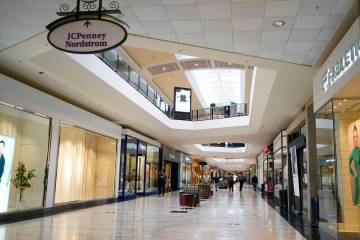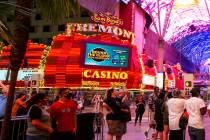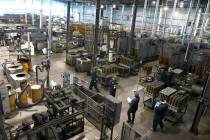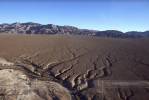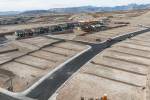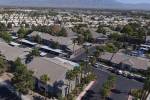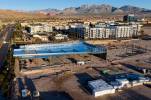Las Vegas now topping neighboring cities in economic recovery, report notes
Finally.
After lagging the Intermountain West region for most of the economic recovery, the Las Vegas Valley has bested nearby cities — and most of the nation — in measures including job growth and housing prices, according to a report last week from the public policy nonprofit Brookings Mountain West.
“Indicators in Las Vegas are uniformly headed in the right direction, which is not the case in a lot of the rest of the region,” said Kenan Fikri, a research analyst with Brookings’ Metropolitan Policy Program and a co-author of the Mountain Monitor report. “You’re one of the strongest, if not the strongest, cities in the Intermountain West.”
Don’t thump your chest too hard: Some of those gains came mostly because Las Vegas stumbled so badly in the recession and lagged so much early in the recovery.
“Just as Las Vegas had an outsized boom, it also had an outsized bust,” Fikri said.
That big downturn left more ground to be gained back once the city started growing again.
Still, for a city that languished for most of the recovery in the bottom 20 for economic performance among America’s 100 biggest cities, 2013 finally brought some economic luck. Las Vegas ranked No. 19 nationally for job growth, jobless declines, home-price gains and economic output in the second quarter.
Las Vegas added 0.8 percent to its jobs base from the first to the second quarter, compared with 0.3 percent in Phoenix and 0.7 percent in Salt Lake City.
Las Vegas’ economic output, or gross metropolitan product, expanded 0.4 percent, outpacing Denver’s 0.2 percent and Albuquerque, N.M.’s 0.1 percent.
Plus, Las Vegas led the 10-city Intermountain West region in housing-price gains, with a jump of 6.5 percent in the second quarter. Phoenix, at 4.6 percent, was a distant second. Some markets, such as Albuquerque, saw housing prices drop.
Though some of Las Vegas’ improvement came from that hard bounce after the big fall, you can also credit broader economic stability, Fikri said.
“As the national recovery progressed, people had that discretionary income again, so it’s not surprising they started taking vacations and traveling again,” he said.
Though the local economy has picked up pace, it has a long way to go to return to prerecession levels.
Despite strong job growth, unemployment budged little from quarter to quarter, probably because once-discouraged workers began returning to the labor pool, Fikri said. The local jobs rate is stalled at 9.7 percent, roughly the same level as the worst national reading three years ago. So Las Vegas is mired at what was crisis-level unemployment for the nation. The city has restored just a third of jobs lost in the downturn.
Stubbornly high joblessness has long-term social and economic consequences, because it means a big chunk of the workforce is losing its skills more and more each quarter, Fikri said.
Housing prices are well below boom-era numbers, too. At the depths of the recession, local homes were worth 34.5 percent of their peak. Today, they’re worth just 40 percent of their highs, the Brookings analysis showed.
What’s more, economic output remains 8.4 percent below its prerecession peak.
It could take half a decade for the economy to bounce back completely, barring another national downturn, Fikri said.
When the economy does come back, it could look a little different. Leisure and hospitality will stay the city’s most important jobs sector for the foreseeable future, but Brookings’ best growers in the second quarter were education, health care and business services.
That’s probably because those fields were undersized before the recession, and are now catching up, Fikri said. He also pointed to a bigger push for economic diversification since the downturn.
Whatever the reason, “your economy is going to look a little different,” he said. “It will bring in a different kind of worker. It will help make Las Vegas slightly less reliant on the earnings of the rest of the country, and less reliant on invisible wealth from a housing bubble that wasn’t real.”
Contact reporter Jennifer Robison at jrobison@reviewjournal.com. Follow @J_Robison1 on Twitter.
COMING RIGHT UP
Las Vegas spent most of the recovery stalled in the bottom 20 percent in economic growth among the 100 biggest U.S. cities. The city began its crawl out of the basement in 2012, and is now among the country’s top performers:
Quarter / National Rank
Second Quarter 2013 / 19
First Quarter 2013 / 20
Fourth Quarter 2012 / 30
Third Quarter 2012 / 62
Second Quarter 2012 / 77
First Quarter 2012 / 96
SOURCE: Brookings Mountain West




